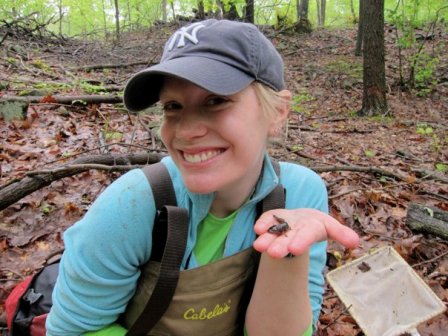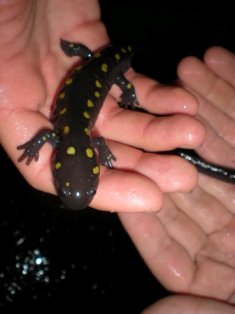Difference between revisions of "Jessie Rack"
Jessica Rack (Talk | contribs) (→Publications) |
Jessica Rack (Talk | contribs) |
||
| Line 18: | Line 18: | ||
I am currently a doctoral student at the University of Connecticut, working for [http://hydrodictyon.eeb.uconn.edu/people/urban/ Dr. Mark Urban]. My research interests are broadly centered around predator-prey interactions of amphibians, specifically with respect to chemical signalling. | I am currently a doctoral student at the University of Connecticut, working for [http://hydrodictyon.eeb.uconn.edu/people/urban/ Dr. Mark Urban]. My research interests are broadly centered around predator-prey interactions of amphibians, specifically with respect to chemical signalling. | ||
<br/> | <br/> | ||
| − | In my "free time" I run, hike, and play | + | In my "free time" I run, read, write, hike, and play music. |
<br/> | <br/> | ||
I'm also on [http://www.facebook.com/jessie.rack Facebook] and have a [http://www.ispellitnature.wordpress.com blog] about the interface between science and poetry. | I'm also on [http://www.facebook.com/jessie.rack Facebook] and have a [http://www.ispellitnature.wordpress.com blog] about the interface between science and poetry. | ||
| Line 46: | Line 46: | ||
==Research Grants== | ==Research Grants== | ||
| − | 2012-2013 University of Connecticut | + | 2013-2014 University of Connecticut EEB Department Vertebrate Award <br/> |
| − | 2011-2012 University of Connecticut | + | 2012-2013 University of Connecticut EEB Department Vertebrate Award <br/> |
| + | 2011-2012 University of Connecticut EEB Department Vertebrate Award <br/> | ||
2011-2012 Sigma Xi Grants-in-Aid of Research <br/> | 2011-2012 Sigma Xi Grants-in-Aid of Research <br/> | ||
2008-2009 Slippery Rock University Faculty/Student Research Grant <br/> | 2008-2009 Slippery Rock University Faculty/Student Research Grant <br/> | ||
Revision as of 21:12, 21 February 2014
Contents
Contact Information
Department of Ecology and Evolutionary Biology
University of Connecticut
75 North Eagleville Road
Storrs, CT 06269
Office: Pharmacy/Biology 211
Phone: 860-486-6154
E-mail: jessica.rack@uconn.edu
About Me
I am currently a doctoral student at the University of Connecticut, working for Dr. Mark Urban. My research interests are broadly centered around predator-prey interactions of amphibians, specifically with respect to chemical signalling.
In my "free time" I run, read, write, hike, and play music.
I'm also on Facebook and have a blog about the interface between science and poetry.
Education
Ph.D. Ecology and Evolutionary Biology
2010-present
University of Connecticut, Storrs CT
B.S. Biology
2007-2010
Slippery Rock University of Pennsylvania
Research Experience: (1) Behavioral Response to Olfactory Cues in the Convict Cichlid, Amatitlania nigrofasciatum, with Dr. Simon Beeching. (2) Sexual dimorphism of electrocommunication signals across populations of weakly electric fish, Apteronotus albifrons, with Dr. Troy Smith.
B.A. Music
2000-2005
West Virginia University
Dissertation Research
My dissertation research focuses on answering questions regarding the behavioral responses of spotted salamander larvae (Ambystoma maculatum) to chemical cues from one of its natural predators, the red-spotted newt, Notophthalmus viridescens. First, I will determine (1) if prey behavior differs in response to local predator chemical cues versus cues from a series of geographically stratified populations of the same predator species and (2) whether larvae can distinguish among predator chemical cues when predator origin is held constant and origin of predator diet (spotted salamander larvae) is varied. I also will (3) take a closer look at the identity of the red-spotted newt chemical cue, with the prediction that it will be the endogenous toxin tetrodotoxin (TTX) or a TTX analogue. Other newt species are known to use TTX as an intraspecific signal of cannibalistic predation risk, and though TTX is found in the red-spotted newt, it has not been tested as a chemical signal. Finally, I plan to (4) separate the effects of environment from genetics in red-spotted newts by performing a predator transplant experiment, in which predators will be raised in environments other than their natal environment, and effects on cue production tested with spotted salamander behavioral experiments. This research will examine whether prey can evolve to recognize the specific chemical cues released by the local predator population, which, if it conveyed higher relative fitness in the prey animal’s local environment, would be evidence for local adaptation. This work will add to an understanding of the evolution of predator-prey interactions in an aquatic environment.
Research Grants
2013-2014 University of Connecticut EEB Department Vertebrate Award
2012-2013 University of Connecticut EEB Department Vertebrate Award
2011-2012 University of Connecticut EEB Department Vertebrate Award
2011-2012 Sigma Xi Grants-in-Aid of Research
2008-2009 Slippery Rock University Faculty/Student Research Grant
Honors and Awards
National Science Foundation Graduate Research Fellowship Program: 2012-2015
University of Connecticut Outstanding Scholar Fellowship: 2010-2013
Beta Beta Beta Alumni Scholarship: 2009-2010
William R. Sigmund PJAS Award: 2009-2010
Frank A. Pugliese "Rock" Scholarship: 2008-2009
Tri-Beta National Biological Honors Society: inducted November 2007. President, 2008-2009, reelected 2009-2010
West Virginia University Presidential Scholarship: 2000-2004
Teaching Experience
EEB 3247 - Limnology: Fall 2011
BIO 1102 - Foundations of Biology: Fall 2010 and Spring 2011
Publications
Ho, WW, JM Rack and GT Smith. 2013. Divergence in androgen sensitivity contributes to population differences in sexual dimorphism of electrocommunication behavior. Hormones and Behavior 63(1):49-53.
Presentations
Rack, J. 2013. Do Ambystoma maculatum larvae evolve to recognize local predator cues? Talk; Annual meeting of the Society for Integrative and Comparative Biology, San Francisco, CA.
Rack, J. 2012. Behavioral responses of Ambystoma maculatum larvae to predator chemical cues on a geographic scale. Talk; University of Connecticut Ecology & Evolutionary Biology Department Graduate Student Symposium, Storrs, CT.
Rack, J. 2010a. Behavioral Response to Olfactory Cues in the Convict Cichlid, Amatitlania nigrofasciata. Talk;
Penn State Behrend-Sigma Xi: Undergraduate Research Conference, Erie, PA.
Rack, J. 2010b. Behavioral Response to Olfactory Cues in the Convict Cichlid, Amatitlania nigrofasciata. Talk;
Slippery Rock University Symposium for Student Research, Slippery Rock, PA.
Rack, J., Ho, W., Smith, G.T. 2009. Sexual Dimorphism of Electrocommunication Signals Across Populations of
the Weakly Electric Fish, Apteronotus albifrons. Poster; Annual meeting of the Society for Integrative and
Comparative Biology, Boston, MA.
Rack, J. 2008. Sexual Dimorphism of Electrocommunication Signals Across Populations of the Weakly Electric Fish, Apteronotus albifrons. Talk; Indiana University’s 2008 Research Experience for Undergraduates in Animal Behavior Presentation, Bloomington, IN.

